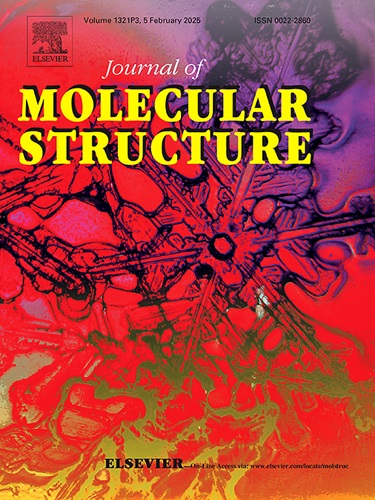Viscoelastic fluids prepared by long chain fatty acid mixture-DMCHA ionic liquid surfactant: Two steps for recycling via pH regulation
IF 4
2区 化学
Q2 CHEMISTRY, PHYSICAL
引用次数: 0
Abstract
Ionic liquid surfactants (ILSs) show great potential for forming wormlike micelles (WLMs) due to their tunable molecular structures. However, their economic and environmental sustainability remains challenging. In this study, a fully recyclable PS-DMCHA ILSs was synthesized from a 1:1 molar mixture of palmitic acid (PA) and stearic acid (SA) (denoted PS) with N, N-dimethylcyclohexylamine (DMCHA). The HOMO, LUMO and molecular electrostatic potential were calculated by Dmol 3 with PBE functional. The formation of WLMs was confirmed through surface tension measurements, rheological analysis, and Cryo-TEM imaging. The recyclability of PS and DMCHA was validated using FTIR, 1H NMR and molecular dynamics simulation. Results revealed that electrostatic interactions and proton transfer drive the formation of ILSs. The long carbon chain of PS contributes to the low surface tension of the ionic liquid system. The combination of PA and SA enables the formation of an ionic liquid at room temperature. When the concentration of ILSs exceeded 6.31 wt %, a wormlike network was formed. Under acidic conditions (pH<4), PS was fully precipitated from the viscoelastic fluids as a solid and separated out, while DMCHA was recovered under basic conditions (pH>12). This study offers valuable insights into enhancing both the economic and environmental feasibility of WLMs as recyclable fracturing fluid systems.

长链脂肪酸混合物- dmcha离子液体表面活性剂制备粘弹性流体:通过pH调节两步回收
离子液体表面活性剂(ILSs)由于其可调节的分子结构而具有形成蠕虫状胶束(WLMs)的巨大潜力。然而,它们的经济和环境可持续性仍然具有挑战性。本研究以棕榈酸(PA)和硬脂酸(SA)(简称PS)与N, N-二甲基环己胺(DMCHA)为原料,以1:1摩尔的混合物为原料合成了完全可回收的PS-DMCHA ILSs。用Dmol - 3计算了分子的HOMO、LUMO和静电势。通过表面张力测量、流变学分析和低温透射电镜成像证实了wlm的形成。通过FTIR、1H NMR和分子动力学模拟验证了PS和DMCHA的可回收性。结果表明,静电相互作用和质子转移驱动了ILSs的形成。PS的长碳链有助于离子液体体系的低表面张力。PA和SA的结合可以在室温下形成离子液体。当ILSs浓度超过6.31 wt %时,形成虫状网络。在酸性条件下(pH> 4), PS作为固体从粘弹性流体中充分析出并分离出来,而DMCHA在碱性条件下(pH>12)被回收。该研究为提高wlm作为可回收压裂液系统的经济和环境可行性提供了有价值的见解。
本文章由计算机程序翻译,如有差异,请以英文原文为准。
求助全文
约1分钟内获得全文
求助全文
来源期刊

Journal of Molecular Structure
化学-物理化学
CiteScore
7.10
自引率
15.80%
发文量
2384
审稿时长
45 days
期刊介绍:
The Journal of Molecular Structure is dedicated to the publication of full-length articles and review papers, providing important new structural information on all types of chemical species including:
• Stable and unstable molecules in all types of environments (vapour, molecular beam, liquid, solution, liquid crystal, solid state, matrix-isolated, surface-absorbed etc.)
• Chemical intermediates
• Molecules in excited states
• Biological molecules
• Polymers.
The methods used may include any combination of spectroscopic and non-spectroscopic techniques, for example:
• Infrared spectroscopy (mid, far, near)
• Raman spectroscopy and non-linear Raman methods (CARS, etc.)
• Electronic absorption spectroscopy
• Optical rotatory dispersion and circular dichroism
• Fluorescence and phosphorescence techniques
• Electron spectroscopies (PES, XPS), EXAFS, etc.
• Microwave spectroscopy
• Electron diffraction
• NMR and ESR spectroscopies
• Mössbauer spectroscopy
• X-ray crystallography
• Charge Density Analyses
• Computational Studies (supplementing experimental methods)
We encourage publications combining theoretical and experimental approaches. The structural insights gained by the studies should be correlated with the properties, activity and/ or reactivity of the molecule under investigation and the relevance of this molecule and its implications should be discussed.
 求助内容:
求助内容: 应助结果提醒方式:
应助结果提醒方式:


